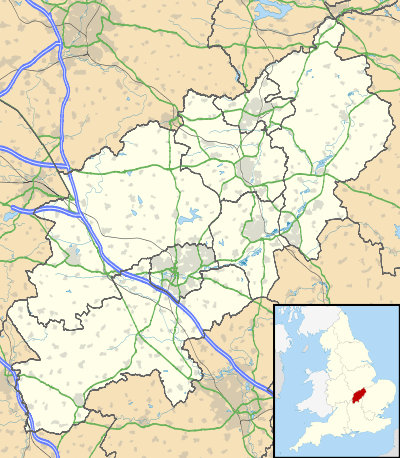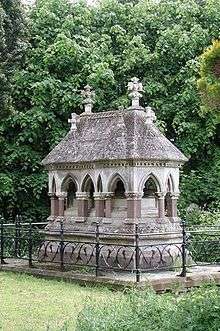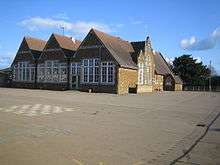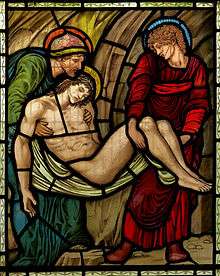Middleton Cheney
Middleton Cheney is a village and civil parish in South Northamptonshire, England. The village is about 3 miles (5 km) east of Banbury in Oxfordshire and about 6 miles (10 km) west-northwest of Brackley. The A422 road between Banbury and Brackley used to pass through Middleton Cheney, but now bypasses it to the south.
| Middleton Cheney | |
|---|---|
 All Saints' parish church | |
 Middleton Cheney Location within Northamptonshire | |
| Population | 3,597 (2011 Census) |
| OS grid reference | SP5041 |
| • London | 72 miles (116 km) |
| Civil parish |
|
| District | |
| Shire county | |
| Region | |
| Country | England |
| Sovereign state | United Kingdom |
| Post town | Banbury |
| Postcode district | OX17 |
| Dialling code | 01295 |
| Police | Northamptonshire |
| Fire | Northamptonshire |
| Ambulance | East Midlands |
| UK Parliament | |
| Website | Middleton Cheney village website |
The 2011 Census recorded the parish's population (including Thenford) as 3,597.[1]
Archaeology and history
Traces of Neolithic, Bronze Age and Roman settlements have been found in the parish. An open field system of farming prevailed in the parish until the 18th century. Parliament passed an Inclosure Act for the parish in 1769 and the parish was surveyed for its inclosure awards in 1770.[2] There is a row of 19th-century almshouses on the former main road through the village.
In 1847 Parliament passed a bill for the Buckinghamshire Railway to build an extension to Banbury. It was built through the south of Middleton Cheney parish, and Farthinghoe railway station was opened in the parish in 1851. It was in the southeast corner of the parish, 1 3⁄4 miles (2.8 km) from the village, on the main road to Brackley. British Railways closed the station in 1952 and the railway in 1963.
The Holt was a house in the parish designed by William Wilkinson. It built in 1864 and demolished in 1973.[3]
The parish used to include the village of Overthorpe, which is now a separate parish.[2]
Churches
Church of England
The Church of England parish church of All Saints is early 14th-century Decorated Gothic. The windows have been renewed but the south doorway is original.[4] The nave has a clerestory, north and south aisles and four-bay arcades.[5] William Edington was Rector 1322–35.[4] He was consecrated Bishop of Winchester in 1345.
The west tower and spire are later Medieval Perpendicular Gothic additions. The top of the spire is about 150 feet (46 m) above ground.[6] In the 18th century the spire survived three lightning strikes: in 1720, 1794 and 1797.[7]
All Saints was restored under the direction of George Gilbert Scott in 1865.[6] During the restoration notable stained-glass windows were added that were designed by the Pre-Raphaelite artists William Morris, Philip Webb, Edward Burne-Jones, Ford Madox Brown and Simeon Solomon and made by Morris & Co. There are also mosaics made by James Powell and Sons, one of which was designed by Henry Holiday.[4][5]
All Saints is now a Grade I listed building.[5]
The west tower has a ring of six bells. Henry I Bagley of Chacombe cast four of them: the tenor in 1640, the second bell in 1659, the treble in 1671 and the third bell in 1680. James Keene, who had bell-foundries at Bedford and Woodstock,[8] cast the fifth bell in 1651. Mears and Stainbank of the Whitechapel Bell Foundry cast the fourth bell in 1881.[9]

All Saints' churchyard has a number of historic grave monuments. Four 17th-century English Baroque headstones and two 18th-century chest tombs are Grade II listed.[10][11][12] The Horton family mausoleum is not listed, but is a Gothic Revival nomument designed by William Wilkinson and made by Thomas Earp in 1866–67.[3]
All Saints is a member of the Chenderit Benefice, which includes the parishes of Chacombe, Greatworth, Marston St. Lawrence, Thenford and Warkworth.[13]
Local amenities

Middleton Cheney has a set of parish meeting rooms, public library, sub-post office, veterinary surgery, pharmacy, supermarket and cookery school. The village has two 18th-century pubs: The Dolphin Inn[18][19] and The New Inn,[20][21] plus a sports and social club.[22]
Middleton has a preschool as well as Middleton Cheney Primary Academy, a primary school for children between the ages of 4 and 11. Chenderit School is a secondary school that includes a sixth form.
Middleton Cheney has a set of playing fields. The village has clubs for cricket, football, karate and tennis. The football club's home ground is in Astrop Road and the first team play in the Oxfordshire Senior Football League. It has a junior section that plays in the Witney and District Youth Football League.
The annual Middleton Music Festival is an annual a rock music festival, usually held in about the second weekend in July.
Vice-Admiral Holland
Vice Admiral Lancelot Holland (1887–1941) was born in Middleton Cheney. He joined the Royal Navy in 1902 and spent the First World War as a gunnery instructor at HMS Excellent. By 1934 he was a rear admiral, and in 1937 he was aide-de-camp to King George VI.
In the Second World War, Holland commanded the 7th Cruiser Squadron at the Battle of Cape Spartivento in November 1940. In May 1941 he commanded the Battlecruiser Squadron when it engaged the German battleship Bismarck in the Battle of Denmark Strait. The magazine of Holland's flagship HMS Hood exploded, breaking her in two and sinking her. Holland was killed, along with all but three of Hood's company.
The Admiral Holland pub in Bretch Hill, Banbury, was named after him. The pub was demolished in 2017.[23]
References

- "Area: Middleton Cheney (Parish): Key Figures for 2011 Census: Key Statistics". Neighbourhood Statistics. Office for National Statistics. Retrieved 9 February 2015.
- RCHME 1982, pp. 101–102.
- Pevsner & Cherry 1973, p. 306.
- Pevsner & Cherry 1973, p. 305.
- Historic England. "Church of All Saints (Grade I) (1371514)". National Heritage List for England. Retrieved 9 February 2015.
- Pevsner & Cherry 1973, p. 304.
- Lewis 1931, pp. 306–310.
- Dovemaster (8 February 2015). "Founders". Dove's Guide for Church Bell Ringers. Central Council for Church Bell Ringers. Retrieved 9 February 2015.
- Hedgecock, James (11 January 2011). "Middleton Cheney All Saints". Dove's Guide for Church Bell Ringers. Central Council for Church Bell Ringers. Retrieved 9 February 2015.
- Historic England. "Chest tomb approximately 8 metres south of south east corner of south aisle of Church of All Saints (Grade II) (1041146)". National Heritage List for England. Retrieved 10 February 2015.
- Historic England. "Chest tomb and 3 headstones approximately 3 metres south of south east corner of south porch of Church of All Saints (Grade II) (1041147)". National Heritage List for England. Retrieved 10 February 2015.
- Historic England. "Headstone approximately 5 metres south of south east corner of chancel of Church of All Saints (Grade II) (1041148)". National Heritage List for England. Retrieved 10 February 2015.
- Archbishops' Council (2015). "Benefice of Chenderit". A Church Near You. Church of England. Archived from the original on 9 February 2015. Retrieved 9 February 2015.
- "The Baptist Church". Middleton Cheney Parish Council. 6 September 2010. Archived from the original on 9 February 2015. Retrieved 9 February 2015.
- The Baptist Centre Middleton Cheney
- "The Methodist Church". Middleton Cheney Parish Council. 6 September 2010. Retrieved 9 February 2015.
- "Middleton Cheney Methodist Church". Circuit Churches. Banbury Methodist Circuit. 2012. Retrieved 9 February 2015.
- Historic England. "The Dolphin Inn (Grade II) (1190705)". National Heritage List for England. Retrieved 9 February 2015.
- The Dolphin Inn
- Historic England. "The New Inn (Grade II) (1190761)". National Heritage List for England. Retrieved 9 February 2015.
- The New Inn
- Middleton Cheney sports and social club Archived 18 December 2014 at the Wayback Machine
- "In Pictures: Banbury's Admiral Holland meets its maker". Banbury Guardian. Retrieved 3 January 2018.
Sources
- Lewis, Samuel, ed. (1931) [1848]. A Topographical Dictionary of England (Seventh ed.). London: Samuel Lewis. pp. 306–310.CS1 maint: ref=harv (link)
- Pevsner, Nikolaus; Cherry, Bridget (revision) (1973) [1961]. Northamptonshire. The Buildings of England (2nd ed.). Harmondsworth: Penguin Books. pp. 304–306. ISBN 0-14-071022-1.CS1 maint: ref=harv (link)
- RCHME, ed. (1982). An Inventory of the Historical Monuments in the County of Northamptonshire. 4, Archaeological Sites in South-West Northamptonshire. London: Her Majesty's Stationery Office. pp. 101–102.CS1 maint: ref=harv (link)
External links
| Wikimedia Commons has media related to Middleton Cheney. |